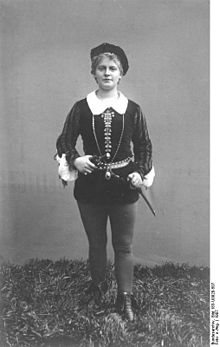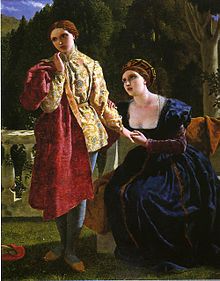- Viola (Twelfth Night)
-
Viola 
Francis Wheatley painted the character Viola preparing to duel, circa 1771Creator William Shakespeare Source Twelfth Night Viola is a fictional character from the play Twelfth Night, written by William Shakespeare around 1599 or 1600.[1]
Violas actions producing all of the play's momentum. She is a young woman of Messaline, a fictional country invented by Shakespeare, although some believe that this country really did exist. [2] in the begging viola is found shipwrecked on the shores of Illyria[2] and separated from her twin brother, not knowing whether he is alive or dead. the Sea Captain that tells her that this place is ruled by the Duke Orsino. He is in love with the Countess Olivia. Viola wants to serve her, but, finding this impossible, she has the Sea Captain dress her up like a boy so she can serve the Duke instead.
Viola chooses the name Cesario, which in Italian means 'little Caesar', and secures a position as a page working for the Duke. he then entrusts Cesario (Viola) to express his love for Olivia because the count is much too cowardly to express his most profound love to Olivia himself.[3] Cesario continues to pass messages back and forth between the Duke and Olivia, but this eventually places her in somewhat of a quandary: she is forced by duty to do her best to plead Orsino’s case to Olivia, but an internal conflict of interest arises when she falls in love with Orsino, and Olivia, believing her to be a man, falls in love with her. This is very bad, but it is resolved towards the end of the play.
When Sebastian, Viola's lost twin, arrives alive and well in Illyria with a pirate named Antonio, the chaos of mistaken identity ensues. The craziness crescendos until eventually Sebastian and Viola (dresses as a man) end up on stage at the same time, which is a huge shock to everyone. The plays ends in marriage: Olivia and Sebastian have already been secretly married (when she mistook him for Viola, whom she believed to be a man and Sebastian was pleased to be loved by such a beautiful woman), and Orsino gives up on Olivia, calling her his sister and takes Viola as his wife.[3]
Art and stage depictions
Circa 1771 Francis Wheatley used actress Miss Elizabeth Younge as a model to paint Viola in Act III, Scene 4 after she and Sir Andrew have drawn swords (painting top-right).[4]
William Hamilton painted the confrontation between Olivia and Viola circa 1797: in Act V, Scene 1 Olivia believes Viola (dressed as Cesario) to be Sebastian (Viola's twin brother) who she has just married. After Viola denies any knowledge, incredulous Olivia asks the priest to confirm they were married just two hours prior.[5]
Walter Howell Deverell used model Elizabeth Siddal in his 1850 painting, showing Viola as Cesario looking longingly at Duke Orsino.[6]
In the mid-19th century Frederick Richard Pickersgill painted a few scenes, including: in Act 1, Scene 4 after the character Viola is shipwrecked, when she cross-dresses as Cesario, enters the service of Duke Orsino as his page and falls in love with him; and in Act 3, Scene 1 when Olivia declares her love for Cesario (1859 painting).[7]
 Lucie Höflich played Viola in a German version of Shakespeare's Twelfth Night in 1907 at the Deutsches Theater
Lucie Höflich played Viola in a German version of Shakespeare's Twelfth Night in 1907 at the Deutsches Theater
In the 20th century German actress Lucie Höflich played Viola in Was ihr wollt (Twelfth Night in German) at the Deutsches Theater in Berlin.[8]
In 2009, Anne Hathaway played Viola in the Shakespeare in the Park's production of "Twelfth Night" in New York's Central Park, directed by David Sullivan.
Connections with other characters
Orsino (the Duke of Illyria) employs Viola as Cesario and she falls in love with him
Olivia (a Countess) mistakenly falls in love with Cesario
Sebastian is the twin brother to Viola
Film Representations
Twelfth Night (1910) – Directed by Eugene Mullin – Viola: Florence Turner
Twelfth Night (1937) – Director N/A – Viola: Dorothy Black
Twelfth Night (1939) – Directed by Michel Saint Denis – Viola: Peggy Ashcroft
Twelfth Night (1957) [TV] – Directed by David Greene – Viola: Rosemary Harris
Twelfth Night (1957) – Directed by Caspar Wrede – Viola: Dilys Hamlett
Twelfth Night (1969) – Directed by John Sichel – Viola: Joan Plowright
Twelfth Night (1974) – Directed by David Giles – Viola: Janet Suzman
Twelfth Night (1980) [TV] – Directed by John Gorrie – Viola: Felicity Kendal
Twelfth Night (1987) – Directed by Neil Armfield – Viola: Gillian Jones
Twelfth Night, or What You Will (1988)– Directed by Paul Kafno – Viola: Frances Barber
Twelfth Night (1992) - [Animated Tales] – Directed by Mariya Muat – Viola: Fiona Shaw
Twelfth Night (1996) - Directed by Trevor Nunn – Viola: Imogen Stubbs
Twelfth Night, or What You Will (1998) [TV] – Directed by Nicholas Hytner – Viola: Helen Hunt
Twelfth Night, or What You Will (2003) – Directed by Tim Supple – Viola: Parminder Nagra
She's the Man (2006) – Directed by Andy Fickman – Viola: Amanda Bynes
Notes
- ^ Garzanti, Aldo (1974) [1972] (in Italian), Enciclopedia Garzanti della letteratura, Milan: Garzanti, pp. 688
- ^ a b Viola (fictional character), enotes.com, http://www.enotes.com/twelfth/viola-character-analysis, retrieved 2009-05-12
- ^ a b http://absoluteshakespeare.com/guides/twelfth_night/summary/twelfth_night_summary.htm
- ^ Shakespeare Illustrated, Emory University, 2003, http://shakespeare.emory.edu/illustrated_showimage.cfm?imageid=321, retrieved 2009-05-12
- ^ Shakespeare Illustrated, Emory University, 2003, http://shakespeare.emory.edu/illustrated_showimage.cfm?imageid=108, retrieved 2009-05-12
- ^ Walter Howell Deverell, Twelfth Night (1850), Emory University, 2003, http://shakespeare.emory.edu/illustrated_showimage.cfm?imageid=53, retrieved 2009-05-13
- ^ Frederick Richard Pickersgill, Viola and the Countess (1859), Emory University, 2003, http://shakespeare.emory.edu/illustrated_showimage.cfm?imageid=82, retrieved 2009-05-12
- ^ (in German) Bundesarchiv - Picture database: Picture archive, http://www.bild.bundesarchiv.de/archives/barchpic/search/_1239710506/?search%5Bview%5D=detail&search%5Bfocus%5D=1, retrieved 2009-04-14
External links
 Media related to Viola (Twelfth Night) at Wikimedia Commons
Media related to Viola (Twelfth Night) at Wikimedia CommonsCharacters in Twelfth Night - Viola
- Orsino
- Olivia
- Sebastian
- Maria
- Toby Belch
- Andrew Aguecheek
- Malvolio
- Feste
- Fabian
- Antonio
Categories:- Fictional characters introduced in 1602
- Characters in Twelfth Night
- Female Shakespearean characters
- 17th-century theatre
- Fictional twins
- Castaways
Wikimedia Foundation. 2010.



